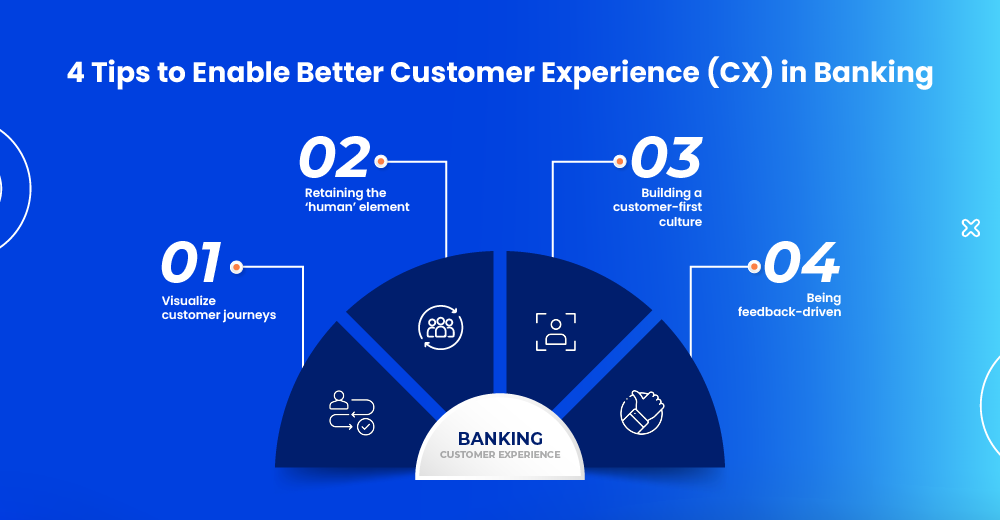Customer experience is paramount in every industry. In the banking world too, it isn’t just about getting their feedback on the service or ensuring on-demand customer support. It’s also about making the customer feel understood, like building propositions that are aligned to their financial goals and aspirations.
Think about it, if you’re someone who travels a lot, a credit card offering you air miles, lounge access or complementary tickets after reaching a said spending limit would resonate more with you than an exclusive credit card offering dine-in deals.
With banking innovations like Banking-as-a-Service, and embedded banking, customer experience is becoming increasingly integrated and holistic, forming an integral component in the customer value chain.
Why Customer Experience is Pivotal in Banking
Customer experience in banking is pivotal and is gaining more momentum than ever because customers today are more empowered, digitally-savvy, and more informed about what they seek from their financial service providers.
If you’re opening a new bank account, a quick scan around your locality will fetch you at least two bank branches, and let’s not forget neobanks too.
With customers having so many options to choose from, if customer experience is not up to their expectations or is merely satisfactory, they can simply switch to another bank.
However, a bank that does offer top-notch customer service and experience will often observe easier customer acquisition, consumption of high-value products like student loans, etc.
In these instances, customers might also confidently opt for just one such bank for all their banking needs instead of having multiple accounts in different banks. Now that we know why customer experience is the glue that holds everything together, let’s take a look at popular customer experience trends in banking!
7 Trends Shaping Customer Experience in Banks
Customer experience in banking is one of the primary points of judgement for a customer to forge relationships that garner trust and loyalty. While most banks are already realizing the crucial role that CX plays, here’s also a look into the customer experience trends in the industry that are reshaping how banking institutions are positioning themselves.
1. Humanizing digital interactions
Transitioning to digital channels is essential, but maintaining the brand’s personality during customer interactions is equally crucial. Banks possess a goldmine of data from over the years, and integrating technological solutions like a CRM and sentiment analysis tools are important for transforming this data into valuable customer insights. Additionally, implementing solutions like chatbots or AI virtual assistants across various customer touchpoints can be a gamechanger.
2. Automating customer onboarding
Customer onboarding plays a pivotal role in shaping the initial impression a customer has of a business. It can significantly impact the overall customer experience, either positively or negatively.
Modern customers prioritize convenience, rapid support, and self-service options over traditional assisted processes.
While traditional onboarding methods involved paperwork and lengthy turnaround times, digitally-native banks now leverage automation and CRM systems to streamline these processes.
This not only enhances efficiency for employees but also ensures a seamless experience for customers.
3. Personalizing advisory services
An article by the Financial Brand pointed out that 40% of customers who have received communication from their provider were dissatisfied with the generic advice they received from their bank.
While customers want contextual products and services, they still want professional guidance about how they can diversify their financial portfolio or how they should go about taking out a loan with better interest rates, etc.
Sure, they can get generic advice and tips from a simple Google search, but designated financial advisors can help personalize their advice based on customer needs.
Tools like a CRM can help banks get a 360-degree view of customers and tailor offerings accordingly based on their previous engagements, products in use, transaction history, and other such factors.
4. Enabling an omnichannel customer experience
Every customer has a preferred channel of communication. Some may prefer call, or an email or even WhatsApp. Hence, customer communication can no longer be on one channel.
Banks must be equipped to adapt to a communication channel that suits the customer’s preferences. Besides, this way, banks can pick up conversations through other channels on-the-go when they have access to conversational history with solutions like a CRM.
It can help reach a customer who may be unresponsive, plug drop-offs, proactively engage with customers to ensure customer journeys are complete and create integrated customer experiences.
When done carefully without leading to cases of spam, it can also promote the brand’s recall, retention, and improve customer accessibility across channels.
About 80% of FIs invest in different technology to engage because an improvement in customer experience can result in higher revenue.
Investments in this context aren’t just limited to investing in technology solutions, but also investing in developing vendor relationships, building new teams, and adding new business operations that all contribute to enabling an omnichannel customer experience!
5. Exploring artificial intelligence
With an increase in the volume of customer queries, a customer service representative may not always be available to attend to them. This can irritate customers and lead to drop-offs.
AI-backed chatbots can help with on-demand service and quicker query resolution.
In a few cases, they can also filter queries that need the assistance of customer service representatives and take them further. From an operational perspective, integrating artificial intelligence can help cut costs, and make better use of data and resources.
6. Tapping into banking-as-a-service
Banking-as-a-Service has allowed banks to reach customers that they traditionally wouldn’t be able to. Also, often called white label banking, in this context, non-banking companies offer products like loans or cards that are associated with a bank.
An example of this would be the Apple credit card, that had a bunch of perks for customers who used it. Or an airline offering a debit card that credits air miles to customers upon every use.
In this scenario, the bank acts as an enabler for fintechs to tap into customer data and create personalized customer experiences. Because after all, you and I don’t dream of taking out a mortgage, we dream about building a home, and that’s something that Banking-as-a-Service enables.
7. Embedded banking
Customers now expect frictionless journeys thanks to BigTech companies like Google and Amazon. With embedded banking, tasks like POS financing have become effortless, eliminating the need to switch between apps for payments.
For example, Buy Now, Pay Later (BNPL) providers such as Klarna or Slice offer installment loans to finance purchases, making the process smoother for customers.
Customer Experience Gaps in Banks
Customer experience in banking can be frustratingly inconsistent, with a significant gap often existing between what customers expect and what they actually receive. These gaps can manifest in various ways, but here are a few common culprits:
- Generic interactions: Customers feel their needs and preferences aren’t understood, leading to robotic interactions and irrelevant product recommendations. This can also happen when communication is extremely transactional.
- Complex onboarding: Lengthy and confusing onboarding processes create friction and leave customers feeling unwelcome.
- Impersonal financial advice: Financial planning feels one-size-fits-all, neglecting individual financial goals and circumstances can make customers feel unacknowledged and reconsider next steps in their customer journey.
- Unintuitive platforms: Banking apps and websites with a conventional user interface can be cumbersome and difficult to navigate, leading to frustration and customer drop-offs.
- Limited support: Lack of readily available or helpful customer support options leaves customers feeling abandoned when they encounter problems.
- Data and security concerns: Non-transparent data practices and unclear security measures create distrust in digital banking solutions in a time where customers are more cautious about where their data is being used.
- Disjointed customer journeys: Information and processes are scattered across departments, leading to inconsistent or frustrating interactions for customers. This is where a centralized CRM system can be a valuable addition to enforce better collaboration.
- Limited financial literacy: Banks often fail to adequately educate customers about financial concepts and tools, leaving them feeling overwhelmed and unsupported. Customers today like to be aware of offerings before they make a decision.
Addressing these customer experience gaps requires banks to rethink people, processes and technology. They must approach this by emphasizing empathy and personalization, investing in user-friendly technology, breaking down internal silos, and building trust and transparency.
By closing these gaps and proactively acknowledging customer needs, banks can build stronger relationships and achieve lasting customer loyalty in a competitive environment. A positive customer experience is not just a feel-good metric; it translates directly to profitability and long-term success!
And here are a few tips on how to build an effective customer experience in the banking industry.
4 Tips to Enable Better Customer Experience (CX) in Banking
Financial institutions may often take up multiple customer experience transformation initiatives parallelly and can see little to no success when there’s an overwhelming change. This is why, it’s key to tread slowly, and not bite more than you can chew!
Nonetheless, here are a few must-know tips that can help build a sustainable approach to rethinking customer experience.

1. Visualize customer journeys
This is the best way to get started. Banks must chart out customer journeys based on their different products and solutions. The journey to open a bank account may be much different than the journey to getting a credit card or opening a recurring deposit. Charting out multiple touchpoints can help define resources and technology solutions accordingly.
2. Retaining the ‘human’ element
As much as customers like self-serve journeys and automated responses, getting access to advisory services, or having a customer service executive can also have a positive impact on feeling seen by a service provider.
3. Building a customer-first culture
There’s always a question about who owns the customer experience? While front-end teams have a major role to play, every other team within a financial institution must work cohesively towards it.
4. Being feedback-driven
Customer experience is a subjective topic. Every customer must be given the opportunity to convey their side of the story. Decide an organized approach to establish a solid feedback loop. This could be in the form of getting ratings, filling out a form or getting on a call with a customer service representative.
In the next section, let’s take a look at an industry example of how banks are going about their customer experience journey.
Banks Building Stellar Customer Experiences (CX)
Here’s a look into how banks are repositioning themselves as customer-centric institutions.
1. Ally
They’re known for their customer-obsessed principles. In a recent interview, Diane Morais, Ally’s President of Consumer and Commercial Banking, said that “the world doesn’t need another bank, but a better bank.”
To measure how well they’re inhibiting the customer-obsessed outlook, they examine data about customer acquisition, retention, the number of products or solutions a customer has in their portfolio, among other parameters. They also use different technology solutions for sentiment analysis and really understand if the needle really points towards the positive or negative side from an organizational point of view.
2. Varo
Varo is also a neobank that’s known for their positioning- ‘a bank for all of us.’
While many brands try doing things out of the box, there’s either a definite success or an unprecedented failure when the message isn’t clear enough.
That way, Varo has always kept things simple without any jargon-filled messaging and being accessible to unbanked and underbanked communities.
They also have a simple take on marketing by sticking to ATL channels to reach a larger audience. Their messaging also focuses on very relatable messaging like instant access to credit at the end of the month, etc.
Conclusion
Banks are not just thinking of being their customer’s financial services providers, they want to be lifestyle partners and mould their role in a customer’s life.
For instance, in India, HDFC has an exclusive Swiggy credit card for customers who use the Swiggy app often. This has made space to offer products and services based on the ‘context’ of a customer’s everyday spending behavior and financial behavior.
According to research by McKinsey, prioritizing customer experience can increase sales conversions by 10-15%.
Customer experience is the keystone to everything today, it’s all about empathizing and anticipating what a customer needs to fuel a top-of-the-mind presence!
If you’d like to explore more about our banking solutions, feel free to get in touch with our experts today!
FAQs
Customer satisfaction in banking can be measured by studying customer retention rates, churn rate, overall feedback received across channels. Sentiment analysis tools can also be used to gauge customer emotions by analyzing recorded calls, social media comments, etc.
Customers expect digital banking experiences to be frictionless, personalized, and on-demand with 24/7 accessibility. These are non-negotiable qualities that customers look for in their financial services providers.
To start off, banks must incorporate strong feedback mechanisms, build a customer-centric culture and have a dedicated CX team that works on top strategies to implement along with newer technology solutions to incorporate in a bank’s tech stack.







